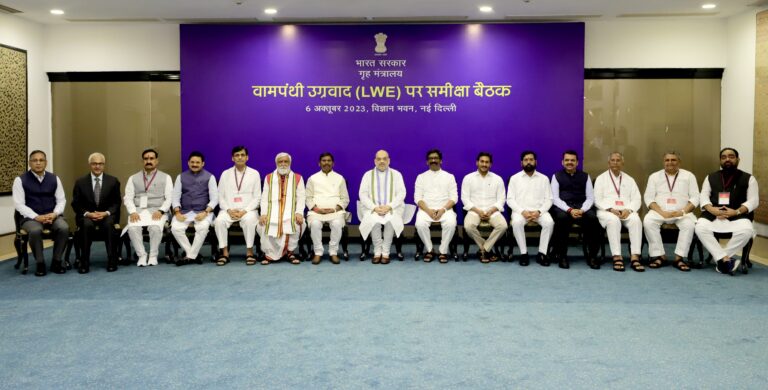Amit Shah: Total Elimination of Left Wing Extremism (LWE) in Two Years

On 6th October 2023, Union Home Minister Amit Shah chaired a review meeting on Left Wing Extremism (LWE) in New Delhi. National Security Advisor Ajit Doval, Union Tribal Affairs Minister Arjun Munda, and Chief Ministers of Maharashtra, Andhra Pradesh, and Jharkhand, Maharashtra Deputy Chief Minister Devandra Fadnavis were a few attendees of the review meeting.
After the review meeting, the home minister emphasized that the LWE would be eliminated from the country in the next two years. He also referred to naxalism as a curse to humanity.
Significant Reduction in LWE Violence in 2022
Union Home Minister Amit Shah, during a recent meeting to review the security situation in LWE-affected States, boldly emphasized that LWE will be completely eradicated from the country within a two-year timeframe. This resolute declaration comes as a result of the significantly reduced violence and casualties in Naxal-affected regions, marking a crucial turning point in the government’s efforts to combat this threat
Lowest Incidents of Violence in Four Decades
Amit Shah proudly asserted that the year 2022 witnessed the lowest number of incidents of violence and deaths in Naxal-hit areas in the last forty years. This noteworthy achievement signals a remarkable decline in LWE-related turmoil, emphasizing the efficacy of the government’s strategies and the dedication of security forces.
Collaborative Efforts in Naxal-Affected States
The representatives from the various states attending this review meeting demonstrated a collective commitment to addressing LWE. Along with the aforementioned names, representatives from Odisha, Bihar, Madhya Pradesh, and Chhattisgarh were also present at the meeting, underscoring the collaborative approach taken by these states in tackling this grave issue.

Policy Measures Yielding Positive Outcomes
Officials have reported a significant 77% reduction in violent incidents in Naxal-affected States in 2022, compared to the peak levels witnessed in 2010. The central government’s ‘National Policy and Action Plan to address LWE,’ introduced in 2015, has played a pivotal role in achieving these positive outcomes. This comprehensive policy employs a multi-pronged strategy that encompasses security-related measures, developmental interventions, and safeguarding the rights and entitlements of local communities.
A Decade of Remarkable Progress
A remarkable transformation in the LWE security situation over the past decade is evident, as indicated by the data prepared by the Ministry of Home Affairs. Between 2004 and 2014, there were a staggering 17,679 LWE-related incidents and 6,984 fatalities. In stark contrast, the period from 2014 to 2023 (up to June 15, 2023) saw a significant reduction, with 7,649 LWE-related incidents and 2,020 deaths. This marked decline, which amounts to a 90% reduction in security forces and civilian casualties compared to the peak in 2010, showcases the consistent progress made in curbing LWE violence.
“There has been a more than 52% decline in LWE-related violence, 69% in deaths, 72% in deaths of security personnel and 68% in civilian deaths, between 2014 and 2023 compared to the period from 2005 to 2014,” the home minister highlighted.
Key Priorities in Combating LWE
“Deployment of CAPFs against left-wing extremism, rationalization of development and setting up camps in vacuum areas are the priorities of the (Prime Minister) Narendra Modi government,” Shah said.
Shah stressed there is “a need to maintain constant surveillance in the areas liberated from LWE so that this problem does not revive there again”.
“There is also a need to monitor that left-wing extremists from areas where this problem has been eliminated do not take shelter in other states,” Shah added.
Way Forward
As the government’s resolute stance and focused policies continue to yield tangible results, the nation moves closer to the ultimate goal of eliminating Left Wing Extremism from its soil. Amit Shah’s announcement serves as a ray of hope and determination, signaling a brighter and more secure future for affected regions.







